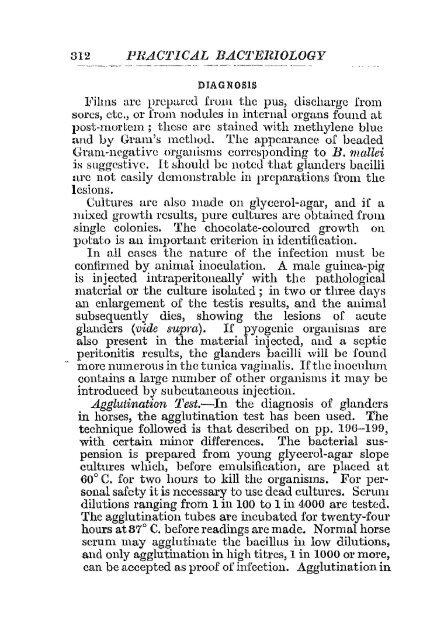AGf~ICULTURAL RESEARCH, PUSA.
AGf~ICULTURAL RESEARCH, PUSA.
AGf~ICULTURAL RESEARCH, PUSA.
Create successful ePaper yourself
Turn your PDF publications into a flip-book with our unique Google optimized e-Paper software.
312 PRACTICAL BAC'l'EIUOLOGY<br />
DIAGNOSIS<br />
Films arc prqmred frum the pus, discharge from<br />
sores, etc., or from nodules ill internal organs found at<br />
post-mortem; these arc stained with methylene blue<br />
and by Gram's method. '1'he appearance of beaded<br />
Gram-negative organisms corresponding to B. mallei<br />
:is suggestive. It :::;hould be noted that glunucr:::; bacilli<br />
arc not easily demonstrable in preparations from the<br />
lesions.<br />
Cultures arc also made on glycerol-agar, and if a<br />
mixeu growth results, pure cultures are obtained from<br />
single colonies. 'rho chocolate-coloured growth on<br />
potato is an important criterion in identification.<br />
In all cases the nature of the infection must be<br />
confirmed by animal inoculation. A male guinea-pig<br />
is injected intraperitoneally' with the pathological<br />
matcrial or the culture isolated; in two or three days<br />
an enlargement of the testis results, and the animal<br />
subsequently dies, showing the lesions of acute<br />
glanders (vide 8upm). If pyogenic organisms are<br />
also present in the material inj eeted, and a septic<br />
peritonitis results, the glanders bacilli will be found<br />
more numerous in the tunica vaginaEs. If the inoculum<br />
contains a large number of other organisms it may be<br />
introduced by subcutaneous injection.<br />
Agglutination Test.-In the diagnosis of glanders<br />
in horses, the agglutination test has been used. The<br />
technique followed is that described 011 pp. 10G-199,<br />
with certain minor differences. The bacterial suspension<br />
is prepared from young glycerol-agar slope<br />
cultures which, before emulsification, are placed at<br />
60° C. for two hours to kill the organisms. For personal<br />
safety it is necessary to use dead cultures. SerulU<br />
dilutions ranging from 1 in 100 to 1 in 4000 are tested.<br />
The agglutination tubes are incubated for twenty-four<br />
hours at 37° C. before readings are made. N onnal horse<br />
serum may agglutinate the bacillus ill low dilutions,<br />
and only agglutination in high titres, 1 in 1000 or more.<br />
can be accepted as proof of infection. Agglutillation in

















